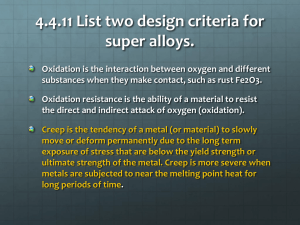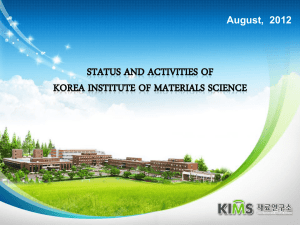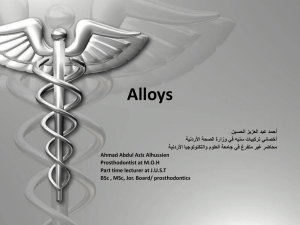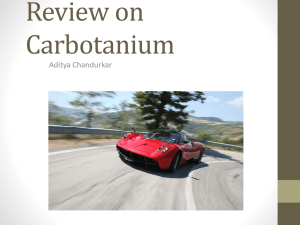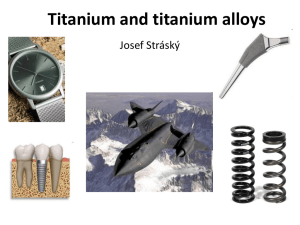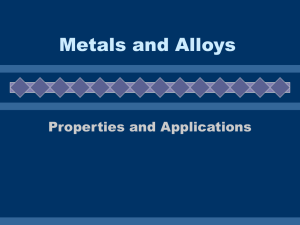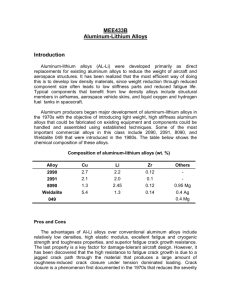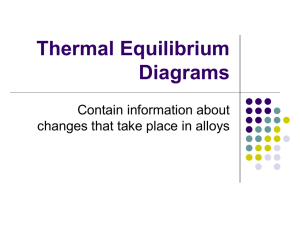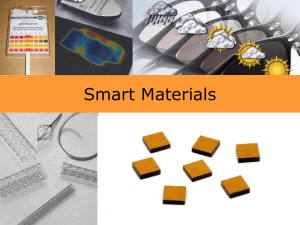Effect of composition on the structure and properties of
advertisement
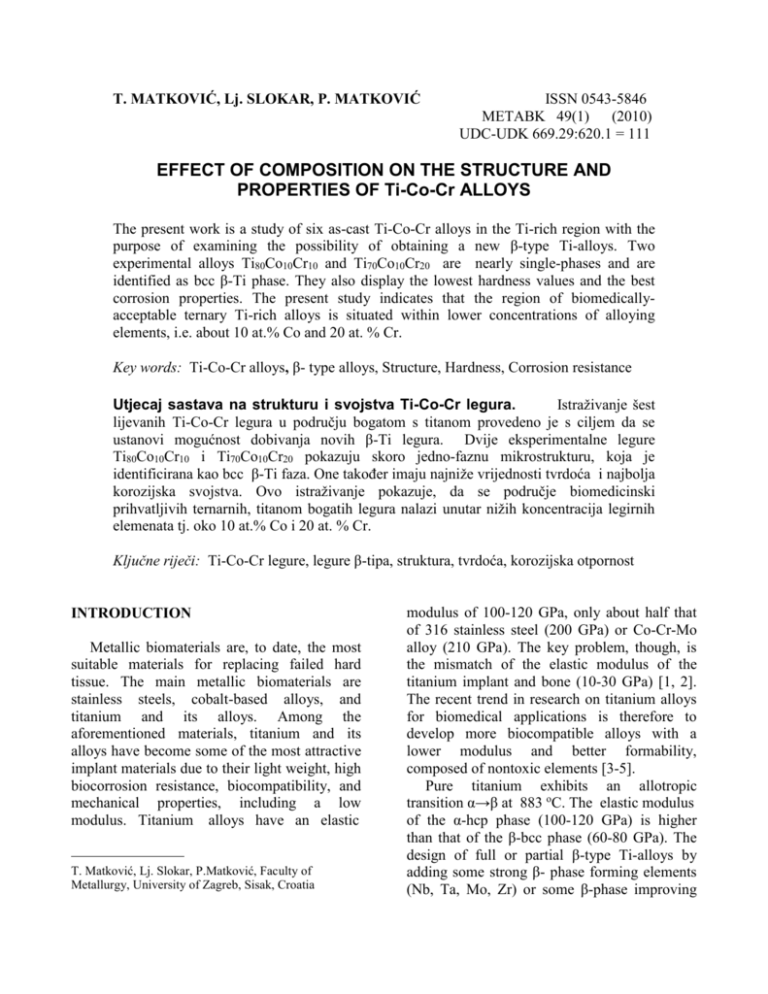
T. MATKOVIĆ, Lj. SLOKAR, P. MATKOVIĆ ISSN 0543-5846 METABK 49(1) (2010) UDC-UDK 669.29:620.1 = 111 EFFECT OF COMPOSITION ON THE STRUCTURE AND PROPERTIES OF Ti-Co-Cr ALLOYS The present work is a study of six as-cast Ti-Co-Cr alloys in the Ti-rich region with the purpose of examining the possibility of obtaining a new β-type Ti-alloys. Two experimental alloys Ti80Co10Cr10 and Ti70Co10Cr20 are nearly single-phases and are identified as bcc β-Ti phase. They also display the lowest hardness values and the best corrosion properties. The present study indicates that the region of biomedicallyacceptable ternary Ti-rich alloys is situated within lower concentrations of alloying elements, i.e. about 10 at.% Co and 20 at. % Cr. Key words: Ti-Co-Cr alloys, β- type alloys, Structure, Hardness, Corrosion resistance Utjecaj sastava na strukturu i svojstva Ti-Co-Cr legura. Istraživanje šest lijevanih Ti-Co-Cr legura u području bogatom s titanom provedeno je s ciljem da se ustanovi mogućnost dobivanja novih β-Ti legura. Dvije eksperimentalne legure Ti80Co10Cr10 i Ti70Co10Cr20 pokazuju skoro jedno-faznu mikrostrukturu, koja je identificirana kao bcc β-Ti faza. One također imaju najniže vrijednosti tvrdoća i najbolja korozijska svojstva. Ovo istraživanje pokazuje, da se područje biomedicinski prihvatljivih ternarnih, titanom bogatih legura nalazi unutar nižih koncentracija legirnih elemenata tj. oko 10 at.% Co i 20 at. % Cr. Ključne riječi: Ti-Co-Cr legure, legure β-tipa, struktura, tvrdoća, korozijska otpornost INTRODUCTION Metallic biomaterials are, to date, the most suitable materials for replacing failed hard tissue. The main metallic biomaterials are stainless steels, cobalt-based alloys, and titanium and its alloys. Among the aforementioned materials, titanium and its alloys have become some of the most attractive implant materials due to their light weight, high biocorrosion resistance, biocompatibility, and mechanical properties, including a low modulus. Titanium alloys have an elastic T. Matković, Lj. Slokar, P.Matković, Faculty of Metallurgy, University of Zagreb, Sisak, Croatia modulus of 100-120 GPa, only about half that of 316 stainless steel (200 GPa) or Co-Cr-Mo alloy (210 GPa). The key problem, though, is the mismatch of the elastic modulus of the titanium implant and bone (10-30 GPa) [1, 2]. The recent trend in research on titanium alloys for biomedical applications is therefore to develop more biocompatible alloys with a lower modulus and better formability, composed of nontoxic elements [3-5]. Pure titanium exhibits an allotropic transition α→β at 883 oC. The elastic modulus of the α-hcp phase (100-120 GPa) is higher than that of the β-bcc phase (60-80 GPa). The design of full or partial β-type Ti-alloys by adding some strong β- phase forming elements (Nb, Ta, Mo, Zr) or some β-phase improving elements (Cr, Fe, Sn) can obviously reduce the elastic modulus. When the elastic modulus is reduced, the strength of the titanium alloy is decreased. Some alloying elements (Co, Cu, Ni) can be used to strengthen the alloys [6-8]. In the present study, the structural, mechanical, and electrochemical characteristics of a series of ternary Ti-rich alloys with cobalt and chromium were investigated. Considering that there are no studies dealing with Ti-Co-Cr alloys and their potential use as biomaterials, the goal of this work was to examine the possibility of obtaining new β-type Ti-alloys. This can be provided by alloying with chromium as the β- phase-improving-element and with cobalt as a strengthener. An X-ray diffraction analysis (XRD) was carried out on polished disc surfaces in the range from 10o to 100o of 2θ value using a Philips PW 3710 diffractometer with CuKα radiation. The phases were identified by matching each characteristic peak with the JCPDS files [9]. Hardness measurements were conducted using the Vickers method (30 N, 10 s) on Otto-Wolpert-Werke equipment. The corrosion behavior of the experimental alloys was examined by the method of cyclic potentiodynamic anodic polarization at a scanning rate of 2 mV/s between -600 and + 1400 mV in aerated 0,9 % NaCl aqueous solution at room temperature. The counter electrode and reference electrode were platinum and saturated calomel electrode (SCE), respectively. The cast disc samples were used as electrodes (working surface cca 34 mm2), so that the non-test surfaces of the specimens were coated with epoxy resin. Surface preparation was done by grinding with 600 grit abrasive paper, followed by thorough cleaning in distilled water, degreasing with ethanol and drying. Pitting corrosion was stimulated by polarizing the specimens to noble potential until the passive oxide film on the metal surface breaks down. The potential of the passive film breakdown, i.e. the pitting potential Epit, is the parameter of interest. MATERIALS AND METHODS Six ternary Ti- rich alloys, with addition of cobalt and chromium, in the range of 10 to 30 at. % were prepared from pure elements (with a purity better than 99,9 %) using a laboratory arc-melting furnace under an argon atmosphere. The samples were remelted many times in order to achieve chemical homogeneity. The buttonlike ingots were approximately 5 g in weight. The casting of the alloys was realized in the same equipment by means of a water-cooled, specially-constructed copper anode that served also as a casting mould. The cylindrical samples with dimensions 7 x 12 mm were sectioned using a Buehler Isomet low-speed diamond saw to obtain specimens for various purposes. Some samples were heat treated in a quartz tube filled with argon at 900 oC during 1 h and then quenched in water. Surfaces of the alloys for microstructural studies were mechanically polished with a standard metallographic procedure to a final level, which was obtained with 0,3 μm alumina powder and then etched in a solution of 50 ml HCl, 5 ml HNO3 and 50 ml H2O. The microstructure of the alloys was characterized by an optical and scanning electron microscope (SEM) Tescan Vega TS 5136 MM type with energy dispersive X-ray (EDX) analyzer. RESULTS AND DISCUSSION The structure, hardness, and corrosion behavior of six Ti-Co-Cr alloys in the as-cast conditions have been studied. The chemical compositions of experimental alloys were selected based on the design principles for Tibase biomedical alloys, so that the cobalt and chromium contents vary from 10 to 30 at. % (Table 1). Optical microscopy shows that most of the as-cast Ti-Co-Cr alloys have multi-phase microstructures. A detailed analysis of the microstructure by SEM with back-scattered electron (BSE) analysis unit shows that alloys 1 and 3 are nearly single phases, alloys 4 and 6 1 indicate the presence of β-phase together with the metastable orthorombic martensitic α,,phase. Beside these two phases, alloy 4 shows the diffraction peaks of intermetallic compound CoTi2, and alloy 6 shows that of Cr2Ti. Alloys 2 and 5 have similar diffraction patterns, which are composed of a metastable hexagonal martensitic α,-phase and intermetalic compound CoTi2 , beside the β- and α,,- phases. After homogenization treatment at 900 oC for 1 h and quenching in water, the XRD-patterns of nearly single phase alloys 1 and 3 show the increase of heterogeneity and more diffraction peaks of intermetallic compound CoTi2. Microstructures of the as- cast and heat-treated sample 1 can be compared in Figure 2 a and b, which exhibit the BSE- microphotographs with the corresponding EDX spectrum. are three-phases, and alloys 2 and 5 are fourphases. The results of XRD-analysis (Table 1) indicate that the crystal structures of as-cast TiCo-Cr alloys are mainly complex, sensitive to the composition of the alloys, and consistent with the microstructural examinations. The diffraction patterns of alloys 1 (Figure 1) and 3 are the most simple and are very similar. They show strong diffraction peaks of body centered cubic β-phase and one weak diffraction peak of CoTi2. These results are in agreement with the investigation of binary Tialloys with β- stabilizing elements in ref. [10]. The microstructure of Ti-Co alloys (with more than 10 mas. % Co) also consisted of β-phase matrix and CoTi2, which precipitated on the grain boundaries of the matrix phase, as a result of eutectoid reaction (β → α + CoTi2) [10]. Table 1. Chemical compositions, results of XRD-analysis and Vickers hardness of as-cast Ti -Co-Cr alloys Alloy /No. Composition /at.% Established phases Hardness / HV 1 Ti80Co10Cr10 -Ti, CoTi2 466 2 Ti70Co20Cr10 -Ti, CoTi2, 805 α'-Ti, α''-Ti 3 Ti70Co10Cr20 -Ti, CoTi2 558 4 Ti60Co30Cr10 -Ti, CoTi2, 632 Figure 1. XRD-pattern of as-cast Ti 80Co10Cr10 alloy ( CoTi2, β-Ti) The results of the hardness measurement (Table 1) reveal the strong influence of the alloy chemistry and microstructure on the hardness values. The nearly single phase alloys 1 and 3 correspond to the lowest hardness values (466 and 558 HV, respectively). All other alloys have multi-phase microstructures (Figure 3 a-d), which display significantly higher hardness values (to 805 HV for sample 2). The explanation of hardness values is complex with regard to various effects, such as α''-Ti 5 Ti60Co20Cr20 -Ti, CoTi2, 688 α'-Ti, α''-Ti 6 Ti60Co10Cr30 -Ti, Cr2Ti, α''-Ti 783 The values of lattice parameter for β-Ti solid solution (a= 0,3181 and 0,3158 nm for alloy 1 and 3) are reduced for 3,8 to 4,5 % against the lattice parameter for pure titanium (a = 0,3306 nm). The XRD-patterns of all other four alloys 2 (a) (b) Figure 2. BSE microphotographs with corresponding EDX spectrum for Ti80Co10Cr10 alloy: (a) as-cast (b) heat treated of bcc β-phase to orthorhombic α'' involves smaller strains than the formation of hexagonal α'- phase. Because of this the α''- phase is less hardened than α'-phase. solid solution strengthening, precipitation hardening, grain size and crystal structure/phase(α', α'', β), which could all affect the hardness of the alloy. The phase transition a) Ti70Co20Cr10 b) Ti60Co30Cr10 c) Ti60Co20Cr20 d) Ti60Co10Cr30 Figure 3. Microphotographs of as-cast Ti-Co-Cr alloys 3 The β-phase alloys generally have higher hardness than α' and α'' probably due to a stronger solid solution effect [11]. This statement could not confirm our findings, because the main factor which influences the hardness of as-cast Ti-Co-Cr alloys is the heterogeneity of their microstructure. The corrosion resistance of the alloys, as the central aspect of biocompatibility, was evaluated on the basis of Epit values. The resistance values have been obtained from cyclic anodic polarization tests in 0,9 % NaCl aqueous solution at 20 oC. Pitting corrosion was stimulated by polarizing the specimen to noble potentials until the oxide film on the metal surface breaks down. The passive oxide film (probably TiO2, the thermodinamically most stable titanium oxide) on titanium alloys forms naturally and protects the underlying, highly reactive titanium metal against uncontrolled chemical or biochemical reactions and corrosion. Martins et al. [12] have established that a more homogeneous oxide film improves the corrosion resistance of titanium alloys. The measured breakdown potential for the present alloys (Table 2) were all higher than 1000 mV and show a very good stability of the passive film. titanium, as one of the most corrosion resistant materials. The effect of the microstructure is also important, because of this, alloys in which the β-phase is dominant display the best corrosion properties. It can be concluded that increased microstructural homogeneity is noble enough to maintain passivity and prevent corrosion. A relatively low Epit value of alloy 6 can be attributed to the presence of Cr2Ti intermetallic compound and its (probably) detrimental effect on corrosion properties. The results of present investigations indicate that, among the six as-cast Ti-Co-Cr alloys, only samples 1 and 3 are nearly single phases and exhibit the desired β-type Ti structure. Owing¸ to the microstructural characteristics, these alloys have superior hardness and corrosion properties. Because of this, the region of biomedically-acceptable ternary Ti-rich alloys is situated within the lower concentration of alloying elements i.e. about 10 at. % Co and 20 at. % Cr. CONCLUSIONS The main results are as follow : Table 2. Electrode potential Epitt (vs SCE) of as-cast Ti-Co-Cr alloys Alloy / No. 1 2 3 4 5 6 Composition /at.% Ti80Co10Cr10 Ti70Co20Cr10 Ti70Co10Cr20 Ti60Co30Cr10 Ti60Co20Cr20 Ti60Co10Cr30 Epitt / mV 1650 1500 1470 1620 1380 1085 Almost all as-cast Ti-Co-Cr alloys have prominent corrosion characteristics, which can be generally ascribed to the presence of 4 Microstructural examinations show that only alloys 1 and 3, with the compositions Ti80Co10Cr10 and Ti70Co10Cr20, have nearly single-phase microstructures. All other alloys have more complex microstructures, which consist of three- or four- phases. The XRD results indicate that the diffraction patterns of alloys 1 and 3 are dominated by the bcc β-phase. This phase is also retained in other four alloys, together with the metastable α,,phase. Beside these two phases, alloys 4 and 6 show the intermetallic compounds CoTi2 and Cr2Ti, respectively. The diffraction patterns of alloys 2 and 5 are composed of metastable hexagonal martensitic α,-phase and CoTi2, in addition to the β- and α,,- phases. The hardness measurement shows that the nearly single phases alloys 1 and 3 have the lowest hardness values. All of the other alloys, with multi-phase microstructures, have significantly higher hardness values. It can be concluded that the hardness of the ascast Ti-Co-Cr alloys increases with the heterogeneity of the microstructure. Almost all experimental alloys reveal high Epit values and very good corrosion characteristics, because of the presence of titanium, which is known for excellent corrosion resistance. The alloys in which the β- phase is dominant also have superior corrosion properties. The present study shows that only alloys Ti80Co10Cr10 and Ti70Co10Cr20 have optimal corrosion and hardness properties resulting from nearly singlephase β-Ti structures. Therefore, the region of biomedically-acceptable TiCo-Cr alloys is situated within the lower concentrations of alloying elements, about 10 at. % Co and 20 at. % Cr. [3] D.Kuroda et al., Design and mechanical properties of new β type titanium alloys for implant materials, Mater. Sci. Eng. A, 243 (1998), 244-249. [4] D.M.Gordin et al., Synthesis, structure and electrochemical behavior of a beta Ti-12Mo-5Ta alloys as new biomaterial, Materials Letters 59 (2005), 2959-2964. [5] M.Niinomi, Recent research and development in titanium alloys for biomedical applications and healthcare goods, Sci. Techn. Adv. Mater. 4 (2003), 445-454. [6] G. He and M. Hagiwara, Ti alloy design strategy for biomedical applications, Mater. Sci. Eng. C, 26 (2006), 14-19. [7] R. Mythili et al., Study of transformation behavior in Ti-4.4Ta-1.9Nb alloy, Mater. Sci. Eng. A, 390 (2005), 299-312. [8] G. He et al., Nanostructured Ti-based multicomponent alloys with potential for biomedical applications, Biomaterials, 24 (2003), 5115-5120. [9] Powder Diffraction File Search Manual, JCPDS International Centre for Diffraction Data, Newtown Square, 2006 [10] Y.Takada et al., Microstructure and corrosion behaviour of binary titanium alloys with betastabilizing elements, Dental Mater. J., 20 (2001) 1, 34-52. [11] W.F. Ho, C.P. Ju, J.H. Chern Lin, Structure and properties of cast binary Ti-Mo alloys, Biomaterials, 20 (1999), 2115-2122. [12] D.Q. Martins et al., Effects of Zr content on microstructure and corrosion resistance of Ti30Nb-Zr casting alloys for biomedical applications, Electrochim. Acta, 53 (2008), 28092817. REFERENCES [1] R.M. Pilliar, Modern metal processing for improved [2] load-bearing surgical implants, Biomaterials, 12 (1991), 95-100. M.Niinomi, Recent metallic materials for biomedical applications, Metall. Mater. Trans. A, 33 (2002), 477-486. Note: The responsible translator for English language is “American Journal Experts” 5 Podaci o autorima Prof.dr.sc. Tanja Matković Faculty of Metallurgy University of Zagreb Aleja narodnih heroja 3 44103 Sisak Croatia E-mail: tmatko@siscia.simet.hr Mr.sc. Ljerka Slokar Faculty of Metallurgy University of Zagreb Aleja narodnih heroja 3 44103 Sisak Croatia E-mail: slokar@siscia.simet.hr Prof.dr.sc. Prosper Matković Faculty of Metallurgy University of Zagreb Aleja narodnih heroja 3 44103 Sisak Croatia Phone: (.385) 44 533 381) 202 Fax: (.385) 44 533 378 E-mail: pmatko@siscia.simet.hr 6
